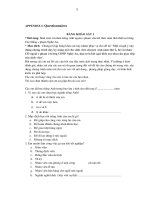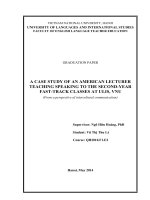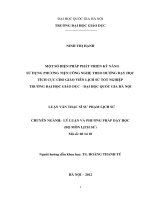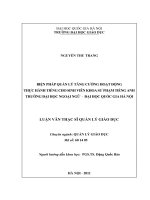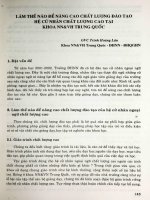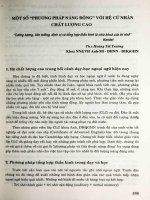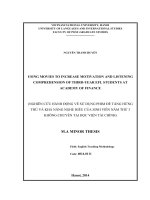TIẾN HÀNH THỰC HÀNH dạy kĩ NĂNG NGHE TRONG một lớp SINH VIÊN năm THỨ 3, hệ cử NHÂN CHẤT LƯỢNG CAO, đại học NGOẠI NGỮ, đại học QUỐC GIA hà nội KHÓ KHĂN và GIẢI PHÁP
Bạn đang xem bản rút gọn của tài liệu. Xem và tải ngay bản đầy đủ của tài liệu tại đây (426.61 KB, 92 trang )
ABSTRACT
In the recent years, the traditional teacher-centered language classroom
which limited the students’ interaction and communication was replaced by learner-
centered approach. Under the light of communicative language teaching and
learning, this new method which included a variety of new activities such as debate,
forum, presentation and especially facilitation in all the four language skills was
widely applied in the university teaching program in Vietnam. In order to help the
students as well as the teachers to understand more about facilitation and its
adaptation, this case study on a class of third year fast-track students from Faculty
of English Language Teacher Education, University of Languages and International
Studies, Vietnam National University, Hanoi, illustrated the difficulties that the
students encountered in conducting a listening facilitation. Also, through three
observations of the activity as well as the results from the questionnaires to 22
participants of this study, the researcher designed the semi-interview questions for
three students and the current listening teacher of the class to search for more
explanation on the difficulties and suggested solutions to overcome those problems.
The most frequently meet difficulty in preparation steps was choosing suitable
materials, writing the transcript of the recordings and designing exercises that
relevant to the students’ levels. The possible solutions to those problems were to
narrow down the theme, practice listening and look for references from standard
books. Meanwhile, in the implementation process, the time limit and questions from
classmates were a great pressure to the facilitators. Moreover, some facilitators were
still nervous during the facilitation and gave unclear instructions to the students. In
parallel, strictly taking control of time and class management as well as carefully
preparation for the anticipated problems in checking exercises sections was
mentioned. Besides, the not-fully-awareness of giving unclear instructions of the
students provided some pedagogical implications for the teacher in guiding them to
carry out facilitation. Besides, this paper would also serve as a source of
information for the next generations of FT students in conducting a listening
facilitation in class.
i
TABLE OF CONTENT
ABSTRACT i
TABLE OF CONTENT ii
LIST OF FIGURES v
LIST OF TABLES vi
LIST OF ABBREVIATIONS viii
CHAPTER I: INTRODUCTION 1
1.1.Statement of the problem and the ra&onale of the study 1
1.2.Research aims and research ques&ons 3
1.3.Signi/cance of the study 3
1.4.Scope of the study 4
1.5.Method of the study 4
1.5.1.Data collec&on instruments 4
1.5.2.Data collec&on procedure 5
1.5.3.Data analysis methods 5
1.6.An overview of the rest of the paper 6
CHAPTER 2: LITERATURE REVIEW 7
2.1. Listening in general 7
2.1.1. De/ni&on of listening 7
2.1. 2. Characteris&cs of listening 7
2.1. 3. Classi/ca&on of listening 8
2.2. Listening in second language learning and teaching 9
2.3. Facilita&on and listening facilita&on 10
2.3.1. Facilita&on in general 10
2.3.2. Listening facilita&on task in connec&on to task-based listening lesson 11
CHAPTER III: METHODOLOGY 13
3.1. Par&cipants and par&cipant selec&ons method 13
ii
3.1.1. A class of third-year students of FT program at FELTE- ULIS-VNU 13
3.1.2. Listening teacher 13
3.2. Data collec&on instruments 14
3.2.1. Ques&onnaire 14
3.2.2. Classroom observa&ons 15
3.2.3. Semi-structured interview 16
3.3. Data collec&on procedure 17
3.3.1. Phase 1: Prepara&on 17
3.3.2. Phase 2: Pilo&ng the ques&onnaire and interview ques&ons 17
3.3.3. Phase 3: Data collec&ng process: ques&onnaire 18
3.3.4. Phase 4: Data collec&on: observa&on 18
3.3.5. Phase 5: Data collec&on: interview 18
3.4. Data analysis procedure 19
CHAPTER IV: RESULTS AND DISSCUSSION 20
4.1. Research ques&on 1 20
4.1.1. Di>cul&es in prepara&on steps 20
4.1.2. Di>cul&es in implementa&on steps 26
4.1.3. Summary of di>cul&es in conduc&ng a listening facilita&on 30
4.2. Research ques&ons 2 32
4.2.1. Recommenda&ons from the students’ perspec&ve 32
4.2.2. Recommenda&ons from the teachers’ perspec&ves 38
4.3. Pedagogical implica&ons 41
CHAPTER 5: CONCLUSION 43
5.1. Major /ndings of the study 43
5.1.1. Di>cul&es and solu&ons in prepara&on steps 43
5.1.2. Di>cul&es and solu&ons in implementa&on steps 44
5.2. Limita&ons of the study 45
iii
5.3. Sugges&ons for further studies 46
REFERENCES 47
APPENDIXES 50
iv
LIST OF FIGURES
Figure 1: Di>cul&es in conduc&ng a listening facilita&on in prepara&on steps as perceived
by third-year fast-track students, FELTE, ULIS, VNU 21
Figure 2: Di>cul&es in conduc&ng a listening facilita&on in implementa&on steps as
perceived by third-year fast-track students, FELTE, ULIS,VNU 28
(See appendix 6, p. 71) 28
Figure 3: Students’ recommenda&ons to the di>cul&es in the prepara&on steps of
conduc&ng a listening facilita&on 32
Figure 4: Recommenda&ons to the di>cul&es in the implementa&on steps of conduc&ng a
listening facilita&on as perceived by the third-year fast-track students, ULIS, VNU 35
v
LIST OF TABLES
Table 1: Roles of teachers’ and students’ in a Task-based lesson 12
Table 2: Di>cul&es encountered by third-year fast-track students, FELTE, ULIS, VNU as
observed by the researcher 26
Table 3: A summary of di>cul&es in conduc&ng a listening facilita&on as perceived by
third-year fast-track students, FELTE, ULIS, VNU 31
Table 4: Review of di>cul&es encountered by third year FT students, FELTE, ULIS, VNU in
prepara&on steps and possible solu&ons 44
Table 5: review of di>cul&es confronted by third year FT students, FELTE, ULIS, VNU in
implementa&on steps and the possible solu&ons 45
vi
LIST OF ABBREVIATIONS
CAE
ELT
FCE
FELTE
FT
L2
LbT
ULIS
Certificate of Advanced English
English Language Teaching
First Certificate of English
Faculty of English Language Teacher Education
Fast-track Program
Second language
Learning by Teaching
University of Languages and International Studies
viii
CHAPTER I: INTRODUCTION
The first chapter states the problem and the rationale of the study, together
with the general aims, objectives and the scope of the study as a whole. Moreover,
the research questions are identified clearly in this chapter and will work as
guideline for the whole research.
1.1. Statement of the problem and the rationale of the study
In the past, the language classroom was defined as a teacher-centered
environment. In the traditional classroom, there had been so many students that the
teacher must use strict discipline to control and organize them. Moreover, the
students might feel bored with the lesson, which was the biggest problem in
teaching and learning in class (Robert, 2010). The students did not have chances to
ask questions in class time but just listened to the lecture and took notes, which
resulted in the lack of interactions between teacher and student and among the
students themselves. Hence, communicative aims were hardly gained. Also, the
teacher led the role as the main speakers all the time which put the students in the
shoes of passive learners.
In recent years, the “learner-centered” teaching has been introduced all over
the world and become more and more popular under the light of communicative
language teaching and learning. Besides, Harmer (2003) also claimed that learner-
centered method can make the learners’ needs and experience central to the
educational process because in this method, the students might practice on their
owns and the teacher would be the guider who instructed the students ways to
achieve the knowledge themselves.
In Vietnam, the learner-centered learning and teaching has brought many
changes in the activities of teaching and learning in university. A numbers of new
kinds of assignments have been designed such as “group discussion”, “pair-
sharing”, “project- based learning”, “facilitation” and “presentation” have been
applied and become popular in university. In University of Languages and
International Studies _ Vietnam National University, Hanoi, the learner-centered
1
approach has been emphasized for recent years, especially in the curricula of Fast-
track (FT) Program in Faculty of English Language Teacher Education (FELTE).
To the English teachers-to-be who came from this program, the most
frequent task they had to carry out was the facilitation, which was applied to all the
four language skills for the whole first three years in university. Take the listening
syllabus of third-year students in FT program as an example. About 20% of the total
grade is allotted to listening facilitation and another 15% is for news sharing
projects, which means 35% of the total grade of listening skill is for facilitation
projects. Similarly, the other language skills also give a large portion of grade for
facilitation related projects. In short, it could be seen clearly that facilitation skills
have been emphasized on during the time in university of fast-track students, which
helped them to practice and sharpen their teaching-related skills.
As a FT student who has spent three years learning in FT program, the
researcher realized that although facilitation had played a very important part in FT
teaching and learning program, the difficulties that the students encountered in the
process of conducting facilitation was not thoroughly taken notice of. Moreover,
there has been no study on this problem can be seen on the school library. Also, the
suggested solutions to overcome those obstacles were just mentioned in the
feedback sections of facilitations in a class only. Hence, the next generations of
students might continue facing with the similar difficulties as the seniors whereas
they could definitely avoid them.
In other words, listening was a very important skill which helps the
communicators to receive the correct information from the speakers and understand
the conversations. Moreover, better listening skills might result in better speaking
and pronunciation skills. To achieve those purposes, listening facilitation is one of
very helpful practice activities. Besides, the researcher herself also found listening
facilitation a very useful activity for the future teacher to practice searching
authentic materials, lesson planning, exercises designing and class management in
learning and teaching listening English.
2
Although many studies about Learning and teaching listening skills were
conducted such as “the exploitation of post-listening activities for 11
th
form students
in Hanoi” by Bui, H. ( 2009), “A research on the difficulties in learning listening
and speaking skills by second year students of FELTE, ULIS_ VNU” by
Nguyen(2008) or “A investigation of factors influencing English listening
comprehension and possible measures for improvement” by Naizhou, G. and Wills,
R. (2010), none of them mentioned listening facilitation. Also, the researcher could
not find any studies on difficulties that the students encountered in conducting a
listening facilitator and possible solutions to those problems. All these reasons have
urged the researcher to do a case- study on:
“Conducting a Listening facilitation in a class of third year students,
Fast-track program, FELTE_ULIS_VNU: Difficulties and Solutions”
1.2. Research aims and research questions
1) What are the difficulties encountered by the third-year students,
fast-track program, Faculty of English Language Teaching Education, ULIS_
VNU in conducting a listening facilitation?
2) What are the possible solutions suggested by the teacher and
students from the fast-track program, FELTE_ULIS_VNU?
1.3. Significance of the study
After having been completed, this study would serve as one of the first
studies on difficulties that students may confront in conducting a listening
facilitation during their third year learning and training in FT program. Hence, this
paper might be useful for teachers, students and researchers who develop an interest
in this topic.
As for the teacher, this study is carried out in order to provide teachers with
possible problems that students usually meet in the process of preparing and
carrying out a listening facilitation. From that point, the un-experienced listening
teacher can detect his/ her difficulties in conducting a listening facilitation in a
third-year FT class and give his/her students helpful advice and comments. Also,
he/ she can find possible solutions suggested by both the teacher and students who
directly carried out listening facilitation for the whole third-year in FT Division.
3
To the students, especially the next generations of FT program who will
follow the listening syllabus including listening facilitation, the researcher hopes
that this paper might be one of the referent sources which supply them with
suggested solutions to overcome difficulties in conducting facilitation.
1.4. Scope of the study
This paper will focus on listening facilitation in a class of third-year FT
program where facilitation activities are emphasized the most in FELTE_ ULIS_
VNU. From that point, the difficulties that the students confront in conducting a
listening facilitation and their possible solutions will be the most important parts of
this research. Besides, this study will also ask for the recommendations from
listening teacher and students from third year FT classes, FELTE-ULIS-VNU.
1.5. Method of the study
1.5.1. Data collection instruments
In order to find the answers to the research questions, survey questionnaires
for students, classroom observations and two interview sets for both teachers and
students will be the main research instruments.
Due to the limit of the study, the size of the sample is taken into
consideration which results in the choice of 22 students from the class chosen and 1
teacher of English Listening Skills who is currently in charge of teaching listening
in this class would be involved in the survey questionnaire, the classroom
observation and the interviews. The researcher chooses to carry out a survey to get
the data about listening facilitation from the students’ perspectives and figure out
their suggestions to overcome the difficulties of conducting a listening facilitation.
Besides, the semi-structured interviews will clarify the problems that the students
confront and the suggested solutions from both the teacher and the students.
Furthermore, the observations will make the data collected more real and objective.
4
1.5.2. Data collection procedure
In general, there were four phases in the process of data collection. Firstly, in
the preparation step, 22 questionnaire and 2 sets of semi-structured interviews were
designed to serve as the main instruments of the study. Besides, the researcher
asked for permission of using materials related to listening syllabus and listening
facilitation. Secondly, the questionnaire and interview questions were piloted into
the third year FT class to get feedback on the format and content of the questions.
Thirdly, the questionnaires were delivered to the students for answers to the
research questions in an appointed day. Besides, 3 observations of the listening
facilitation were conducted so that the researcher could take note the useful
information that related to the research. Last but not least, four appointments for 4
interviews to the students and listening teacher were made beforehand. The
researcher used the answers from the questionnaires and the notes from three class
observations to draw an initial idea about the major difficulties and
recommendations to call for more information from the interviewees.
1.5.3. Data analysis methods
In order to find the answers to the two research questions, both the
quantitative (questionnaire) and qualitative (observation and interview) method to
collect the data for this study.
For the questionnaires, the data will be analyzed and classified according to
the research questions. Research question one is about the difficulties in conducting
a listening facilitation; hence, all difficulties collected from the students in the
questionnaire will be summed up and categorized into sections: difficulties in
preparation and in implementation. The most frequent problems will be counted and
ranked in order. For the question two, the procedure of analysis is also the same.
In terms of the observations, with the help of observation checklist, the
researcher will number and analyze all the difficulties seen in the listening
facilitation. Those figures will be compared with the findings from the survey
questionnaires.
5
Regarding the semi-structured interviews, the transcripts will be in written
form. After that, the answers to each research question will be grouped and
compared with the questionnaires to find out similarities and differences. Moreover,
the interviews will be a great help in specifying thorough solutions to the
difficulties in preparation and implementation.
1.6. An overview of the rest of the paper
The rest of the paper includes 5 chapters as follows:
Chapter 2: (Literature Review) provides the background of the study,
including the key concepts, the description of the application of listening facilitation
in fast-track program of FELTE-ULIS-VNU and the discussion of the related
studies.
Chapter 3: (Methodology) describes the participants and instruments of the
study, as well as the procedure which were used for carrying out the research.
Chapter 4: (Findings and discussions) analyzes the findings of the research
according to the two research questions.
Chapter 5: (Conclusion) summaries the main issues discussed in the paper,
the limitations of the research and several pedagogical recommendations relating to
the research topic as well as some suggestions for further studies. Following this
chapter are Reference lists and Appendices.
6
CHAPTER 2: LITERATURE REVIEW
This second chapter sheds light on the literature of the study; especially the
definitions and classifications of the terms as well as a number of studies related to
the research topic will be provided.
2.1. Listening in general
2.1.1. Definition of listening
There have been many different definitions of listening proposed by different
researchers and educators for years. In the simple way, listening was defined as “the
ability to understand spoken language” (Rankin, 1952, cited in Thanajaro, 2000,
p.11). Besides, Nichols (1948, cited in Andrew, 2012, p. 204) also simplified that
listening is “an attachment of meaning to oral symbols”. Meanwhile, Petrie (1964,
cited in Andrew, 2012, p.204) defined listening as “the complete process by which
the oral language communicated by some source is received, critically and
purposely attended to, recognized and interpreted (or comprehended) in terms of
past experiences and future expectancies”. In other words, Purdy (1997, p.8)
proposed another definitions proposed another definition which was “ the active
and dynamic process of attending, perceiving, interpreting, remembering, and
responding to the expressed( verbal and nonverbal), needs, concerns, and
information, offered by other human beings”.
Some other definitions of listening were proposed by different scholar in this
section. As far as it was concerned, listening is “the ability to identify a speaker’s
accent or pronunciation, his/ her grammar and his/ her vocabulary, and grasping
his/ her meaning. An able listener can do these four things simultaneously”. (Goh,
2002, cited in To et al. 2007, p. 5). To be specific, the other skills such as
pronunciation, grammar, vocabulary and meaning are needed for a listener to
receive, clarify and understand the spoken information.
2.1. 2. Characteristics of listening
It was not until 1955 that the term “active listening” was coined by Carl
Rogers to “describe the facilitative function of listening with empathy” (Thomlison,
1984, p. 5). According to Thomlison, active listening involved not only what was
7
said, understanding meaning and recall facts, but also included “listening beyond
the words” to the affective and feeling component of the message. In the meantime,
Helgesen ( 2003) pointed out that listening was “very active” and while listening,
the listener had to “ connect” the information to their own ideas or experience, by
that way they were “ creating the meaning in their own minds”.( P. 24).
In order to perform a listening comprehensive process, the listener had to
activate their background knowledge including linguistic competence, sociocultural
competence, strategic competence and discourse competence. (Douglas, 1988:
Dunkel, 1991b: Faerch & Ksper, 1986: Robinett, 1978: Scacella & Oxford, 1992:
Shrum & Glisan, 1999, cited in Thanajaro, 2000, p.14). To be specific, linguistic
competence referred to the learners’ command over major components of language
such as phonology, lexicon, syntax, semantics and text structure. Sociocultural
competence was about the “listeners’ degree of familiarity” with the social aspect of
the message and the knowledge of the social as well as cultural expectation of
native language speakers. Strategic competence meant the ability of the listeners to
guess meanings of unfamiliar words and compensate their missing knowledge by
using their own strategies. Last but not least, the ability to use cohesive devices to
link meaning across sentences was the thing discourse competence described.
In short, listening was a man’s important skill in communicative reaction
because it was an active process of receiving information based on the speech
sounds. During the listening process, a variety of knowledge such as linguistic,
sociocultural, strategic and discourse knowledge was activated to help the listeners
fully understand the content as well as the emotional message from the
conversation.
2.1. 3. Classification of listening
There have been a number of different ways to classify listening into
different types. Baker (1971) based on the different situation to divide listening into
active- passive and serious-social. In his opinion, active listening was to listen with
a specific purpose whereas passive listening was no more than hearing. ( p9-13).
8
Concerning the purpose of listening, Harmer( 2001) and Goh ( 2002, cited in
To et al., 2007, P.7) classified listening into five main types as followed:
- Listening for general understanding: listeners only catch the general ideas
out of what was said but not focus on single words. Those who were good at this skill
could understand the gist of the discourse without worrying too much about the details.
- Listening for specific information: in some situations, listeners only cared
about some specific details out of the piece of listening. Hence, they might ignore
all the other information until they come to a specific item they were looking for.
- Listening for detailed information: listeners targeted at catching every
piece of information they could listen to. Usually, they need this skill in listening to
a set of direction or instruction such as airport announcement or telephone number.
- Predicting and guessing: in the process of listening, listeners often predict
what was coming and guess the content from the initial hearing. Then, the
subsequent listening helped to confirm their prediction or expectation.
- Interpreting: this type of listening happens when listeners based on the
words to guess the speakers’ implications or suggestions. Normally, the shared
knowledge between the speaker and listener played an important role in the success
of this interpretation.
2.2. Listening in second language learning and teaching
Since 1990s, Mac (1990) stated the idea that listening was a great important
skill because “the ability to understand what others say” was essential to the
“communicative interaction”. Moreover, listening was the most frequently used
language activity because “45 percent of the time adults spend in communication
activities is on listening, 30 per cent on speaking, 16 per cent on reading and 9
percent on writing”( Rivers & Ternperley, 1978, cited in Mac, 1990, P. 6).
However, this skill was claimed to be “the most neglected skill in language
teaching” ( Paulston, 1976). Furthermore, listening skill was characterized as a
“passive process”( Nunan, 2003) or “receptive process”( Mac, 1990), which could
be the cause of the lack of listening skill teaching in class, though it accounted for
“57.5 percent of the daily classroom time” (Wilt, 1950).
9
However, listening has been gaining greater and greater importance in
language learning in teaching. Rost ( 2002, cited in Yang, 2006, p. 65) elaborated
that listening provided input for the learners which helped students to begin the
process of acquiring the language. In other words, listening could help students
build vocabulary, develop language proficiency, and improve language usage
(Barker, 1971). In addition, Dunkel (1986) also stated that developing proficiency
in listening comprehension was the key to achieving proficiency in speaking.
Apparently, listening was considered the basis for the development of all other
skills as well as the channel that helped students make initial contact with the target
language and its culture. (Curtain & Pesola, 1988, cited in Thanajaro, 2000, P.2).
In conclusion, listening played a very important role in daily conversation for
providing the comprehensive input for acquisition process of receiving information.
2.3. Facilitation and listening facilitation
2.3.1. Facilitation in general
According to Gaffney (2000, cited in Nguyen, 2011, p.28) facilitation was
described as the process of “enabling groups to work cooperatively and effectively”.
Moreover, facilitation is “important in circumstances where people of diverse
background, interests and capabilities work together”. In other words, facilitation
was defined in the curriculum of Bonner Foundation (n.d, p. 2) as “the process of
helping participants to learn from an activity”.
Regarding this problem, Baltimore mediation Center (2009, cited in Nguyen,
2010, P.28) illustrated the term “facilitation” as “a process for groups of people
who need to have open dialogue about topics or issues that are high priority to
them”. The activities might contain discussions about “hard, complicated and
difficult matters” or critical decision making, which encourage students to share
their own ideas and better understand the content of the lesson.
In general, facilitation was considered the process when the facilitators raised
the problems under a theme or topic chosen and then instructed the participants to
get through discussions or activities so as to solve the problems and widen the
background knowledge about the theme. Due to the limit of the study, the
10
researcher exploited this term as the process when the group of facilitators together
found out the suitable materials for the sections, explored them and then designed
activities as well as exercises to help their classmates understand those materials at
the same time of practicing listening skills.
2.3.2. Listening facilitation task in connection to task-based listening lesson
According to the requirement of the fast-track program curriculum, the
students had to carry out the listening facilitation in the third-year with the
following requirements of the materials:
- In group of two, record one listening passage in authentic English to be used in
your group’s facilitation session. The content of the recording(s) should be in line with the
theme of the week you are in charge of.
- The passage can be recorded from the radio, cable TV, internet resources, or live
with English native speakers (but not by giving a written passage for him/her to read).
Each passage should last from 5 to 10 minutes. You must not use the listening materials
from test or textbooks (See Appendix 4, p. 58 )
Beside no limited genres of recordings was mentioned, the quality of the
recording should be good enough for the facilitation. Also, fairly divided workload
among members of group was encouraged. In the preparation process, the groups of
facilitators needed to:
- Write the transcript of the recording.
- Design exercises based on the recording with a view to developing a certain
listening skill in your classmates. Please refer to the objectives of the course for details on
what skills you should focus on in this semester.
- Write a lesson plan which outlines what you plan to do in the session and when
(See Appendix 4, p. 59)
Furthermore, they needed to submit all those materials a week before the
facilitation, received the teacher’s feedbacks and made adjustments. In the implementation
steps, they must conduct the facilitation in class with an effort to demonstrate a good
control of the class and of the listening tasks. In 45 minutes, they tried to meet their
classmates’ need(s) and achieve the objectives of their session.
After the facilitation, they needed to:
11
- Receive feedback from peers and the teacher, and make adjustments accordingly
to improve your lesson plan and exercises.
- Write a reflective report which (1) describes all the steps you took in preparing,
delivering the session, and improving the lesson plan and exercises, (2) comments on your
overall performance, strengths and weaknesses, and (3) suggests solution(s) to the
identified problems, if any.
(See Appendix 4, p. 59)
In short, the role of the facilitator was somehow the same as the teacher’s
role in a task-based listening lesson with three steps including pre-listening, while
-listening and post - listening. Richards and Rodgers (2001, cited in Nguyen, 2011,
p.29) summarized the teacher’s role and facilitator’s role as followed:
Teachers’ role Facilitators’ role
− A selector and sequencer of tasks
− Preparing learners for tasks
− Consciousness-raising
− Group participant in pair work or group
work
− A monitor
− A risk-taker and innovator
Table 1: Roles of teachers’ and students’ in a Task-based lesson.
To sum up, listening facilitation was a task-based lesson conducted by the
students themselves so as to practice both the listening skill and facilitating skill
which were very useful for the future teachers.
Summary
In this chapter, the key terms as well as the context of conducting listening
facilitation in a class of third year students were viewed by theoretical background
of the study. To be specific, the concept of listening and listening facilitation were
clarified in the context of teaching and learning foreign language where the
listening skills played a very important role in developing the learners’ language
skills.
12
CHAPTER III: METHODOLOGY
In the preceding chapter all the theoretical basis of the study was mentioned
as a guide through the paper. In this chapter, the methods of data collection and
analysis would be justified in order to maximize its validity and reliability of the
final results. To be more specific, the participants, the instruments as well as the
procedures of data collection and analysis would be discussed in detail as follows.
3.1. Participants and participant selections method
3.1.1. A class of third-year students of FT program at FELTE- ULIS-VNU
Since the valid and reliable answers from the students’ perspective to the two
research questions play the vital role to the success of this research, the participants
must be the students who directly spent their time and effort conducting a listening
facilitation in a FT class. Another reason is the curriculum of FT program
emphasized on learner-centeredness; hence, the contribution of the students was
considered the reliable source so that the researcher could seek for the answers to
the two research questions. For the above-mentioned reasons, a group of 22 students
from a third-year FT class were chosen to help answer the questions about third-
year students’ difficulties in conducting a listening facilitation through
questionnaires and interviews.
3.1.2. Listening teacher
This research focused on finding out the difficulties that the third-year
students confront in conducting a listening facilitation and the possible solutions to
those problems. Hence, based on the findings of the questionnaires and the
interviews for students, the researcher then would interview the listening teacher
with the related questions for the sake of figuring out the guide for the students to
face with their difficulties. These recommendations might be a great help to the
students who would carry out listening facilitation in future. On the other hand, the
students who experienced conducting a listening facilitation also have one more
chance to look back their facilitation and improve themselves in facilitation
activities in other skills and even in their teaching career later on. Therefore, the
13
participation of the listening teacher in data collection process was really significant
to the success of this study.
Since this research paper was carried out as a case study, the listening
teacher was chosen for a semi-structured interview in which the teacher could share
her experience in teaching listening and listening facilitation. Furthermore, the
recommendations to overcome problems in conducting a listening facilitation would
be given. Specifically, the suggested solutions to ace with listening facilitation
would be clearly guided by an experienced teacher who has had a long time
working with FT classes and listening program, which would be a treasuring source
of tips for the students.
Last but not least, this teacher has experienced in teaching at FT program,
FELTE-ULIS, which would be an advantage for her to give out helpful, reliable and
valuable answers to the researcher’s interview questions.
3.2. Data collection instruments
In order to obtain reliable and valid result, the survey questionnaire of
quantitative and interview as well as classroom observation as methods of
qualitative approach are fully exploited.
3.2.1. Questionnaire
According to Nunan (1989, cited in Hoang and Nguyen 2006, p.10), the
questionnaire is a very helpful instrument because it helps save researcher’s time,
researcher’s effort and financial resources. Besides, by using this instrument, the
researcher can collect a large amount of information from a large number of
participants within a short period of time (Nguyen 2007, p18). Consequently, the
researcher wants to take advantages of this instrument when using a survey
questionnaire for students. The format of the questionnaire in this research was
adapted from the study “Conducting a reaching facilitation based on LbT method in
a class of third-year students, FELTE, ULIS, VNU: Difficulties and Solutions” by
Nguyen Thi Huyen Trang in 2010 due to the similarity in the research topic and
methodology. Besides, the participants were also the third year FT students from
14
FELTE, ULIS, VNU. However, some questions were edited to make it suitable for
the topic of difficulties and solutions of a listening facilitation.
The questionnaire was completely designed in English because the FT
students were supposed to be competent in using English. In response to the two
research questions, the questionnaire was divided into two main parts which are the
difficulties and solutions. The first part included two big questions about the
difficulties that students might encounter in the preparation and implementation
steps of a listening facilitation. There were 11 statements for the first step and 6
sentences for the implementation process. In this question, students were asked to
rate the difficulty level of the facilitation by answering “ Strongly Agree”, “
Agree”, “ Undecided”, “Disagree” or “ Strongly Disagree” to each statement. After
getting the questionnaire done, the researcher collected the data and analyzed it to
find out the most striking difficulties that the students often encountered in both
steps (preparation and implementation). From that point, the research would
concentrate more to the possible solutions to the most difficult problems of the
students. Also, the open-ended questions were used for the students to point out
their other problems which were not mentioned in the above statements in both
steps. In other words, the combination of both types of questions would help to
facilitate the data collection and analysis, as well as the comprehensive collection of
information (Nunan 1989, cited in Hoang and Nguyen, 2006, p.21).
3.2.2. Classroom observations
According to Cohen, Manion and Morrison( 2000, p.305, cited in Chu, 2009,
p.31), observation method was described as “ observational data are attractive as
they afford the researcher the opportunity to gather the ‘live’ data from ‘live’
situations”. As a result, this instrument was very useful for the researcher to collect
the “live” data right from the time of facilitation and note down the remarkable
difficulties of the students as well as their solutions.
Besides, this research instrument was a method of “generating data which
involve the researcher immersing [him or herself] in a research setting, and
systematically observing dimensions of that setting, interactions, relationships,
15
actions, events and so on, with it” ( Mason, 1996, cited in Mackey and Gass, 2005,
p.175). Specifically, by using this instrument, the research did “immerse” herself
into the learning environment of the class 09.1.E1 as a student and participated in
the listening facilitation. From that point of view, the researcher gained insights into
the context of the participants and carefully followed the facilitation to produce the
reasonable and reliable notes about the implementation step of the activity.
It could be seen clearly from the reasons above that classroom observation
was a very important instrument that helped answering the two research questions.
As mentioned earlier, the observation form would be the field notes which allowed
the research to note down any useful information for the study. Those notes were
analyzed and classified into six possible difficulties in the implementation step of
the listening facilitation. Based on this information, the research could make
comparison with the answers from the questionnaire and the interview to see the
awareness of the students about their own problems.
3.2.3. Semi-structured interview
Beside the questionnaire and observation, the semi-structured interview for
the teacher and students was the third instrument used in this study. This
instrument could help the researcher to “produce extraordinary evidence about life
that you don’t get in structured interviews or questionnaire methodology”( Dowsett,
1986 cited in Pham & Luong, 2009, p.52). Therefore, if there were any problems
that could not be clarified through the questionnaire and be interpreted by the
observations, then the semi-structured interview would serve the ultimate goal of
getting insight to the issue. The format of the interview questions was also adapted
from the study “Conducting a reaching facilitation based on LbT method in a class
of third-year students, FELTE, ULIS, VNU: Difficulties and Solutions” by Nguyen
Thi Huyen Trang in 2010 due to the similarity in the research topic and
methodology. However, some questions were changed to be relevant to the topic of
listening facilitation.
There were 2 sets of interview questions including one for the students and
one for teacher. There were three interviews with three students who were
16
recommended by the listening teacher. Afterwards, the information collected was
grouped into different common problems. Based on those difficulties, the researcher
added a number of questions into the set of interview questions for the current
listening teacher so that some specific recommendations to deal with them would be
given clearly.
All of the four interviews’ result served as important information to help
answer the two research questions of this study. The difficulties that the students
encountered and were aware of as well as the problems that their teacher took notice
of through facilitations were clearly clarified. Also, the suggested solutions from the
facilitators and listening teacher were a great help to the next generations of fast-
track students to ace with listening facilitation, which was the answer to the second
research question in this study.
3.3. Data collection procedure
In general, there were four phases in the process of data collection as
followed:
3.3.1. Phase 1: Preparation
To prepare for the data collection process, 22 questionnaire and 2 sets of
semi-structured interviews were designed. The participants were 22 third-year FT
students and their listening teacher. After that, the researcher asked for the teacher’s
permission for delivering the questionnaires to the students and collecting the data.
The information about this process was informed to the students beforehand. For
the classroom observations, the researcher asked for the listening syllabus and the
group list from the students. Based on those materials, the researcher made decision
on the days of facilitation. For the interview, the listening teacher and three students
were asked for approval and then the appointments were made. The personal
information of the participants was kept confidential and anonymous for the ethical
reasons.
3.3.2. Phase 2: Piloting the questionnaire and interview questions
The second phase was the data collection process. In this phase, the
researcher delivered the questionnaire to 4 students, asked them to read carefully
17
the instructions and try to answer the questions. After that, the feedbacks from the
students about the overall appearance of the questionnaire, the clarity of the
instructions as well as the clearance of the questions were carefully taken. The
finalized questionnaires and interview questions were improved from the first drafts
and delivered to the students and teacher later on to get the data for this study.
3.3.3. Phase 3: Data collecting process: questionnaire
The researcher made the copies of the questionnaires and handed them to 22
students. All the information including the topic of the research and the significance
of the questionnaire to the success of the study were introduced to the participants
before they were asked to answer the questions. Also, if the students had any
question or doubt about the questionnaire, they could ask immediately. While the
students were answering the questionnaires, the researcher went around the class to
clarify the problems as soon as it was raised.
3.3.4. Phase 4: Data collection: observation
After processing the data collected from the questionnaires, the researcher
carried out 3 observations when the listening facilitations were conducted. During
the observations, the researcher took notes of the difficulties that the facilitators
encountered, which was useful for answering the two research questions.
3.3.5. Phase 5: Data collection: interview
The appointments for the interviews were scheduled beforehand via
telephone to concisely explain the purpose, the nature of the research topic and to
invite the participants as well. Moreover, the researcher got the permission from the
interviewees to record the interview so that the data analysis would be easier and
more concisely. Also, the identity of the participants was sure to be kept in secret.
Besides, the answers from the questionnaires and the notes from three class
observations were summed up and analyzed so as to draw an initial idea about the
major difficulties and recommendations. Therefore, the more focus would be paid
on the certain questions of the interviews.
The interviews were conducted in Vietnamese so that the interviewees would
felt it easier to express his/ her ideas and feelings towards listening facilitation
activity. To begin with, the researcher and the interviewee had a short conversation
18
